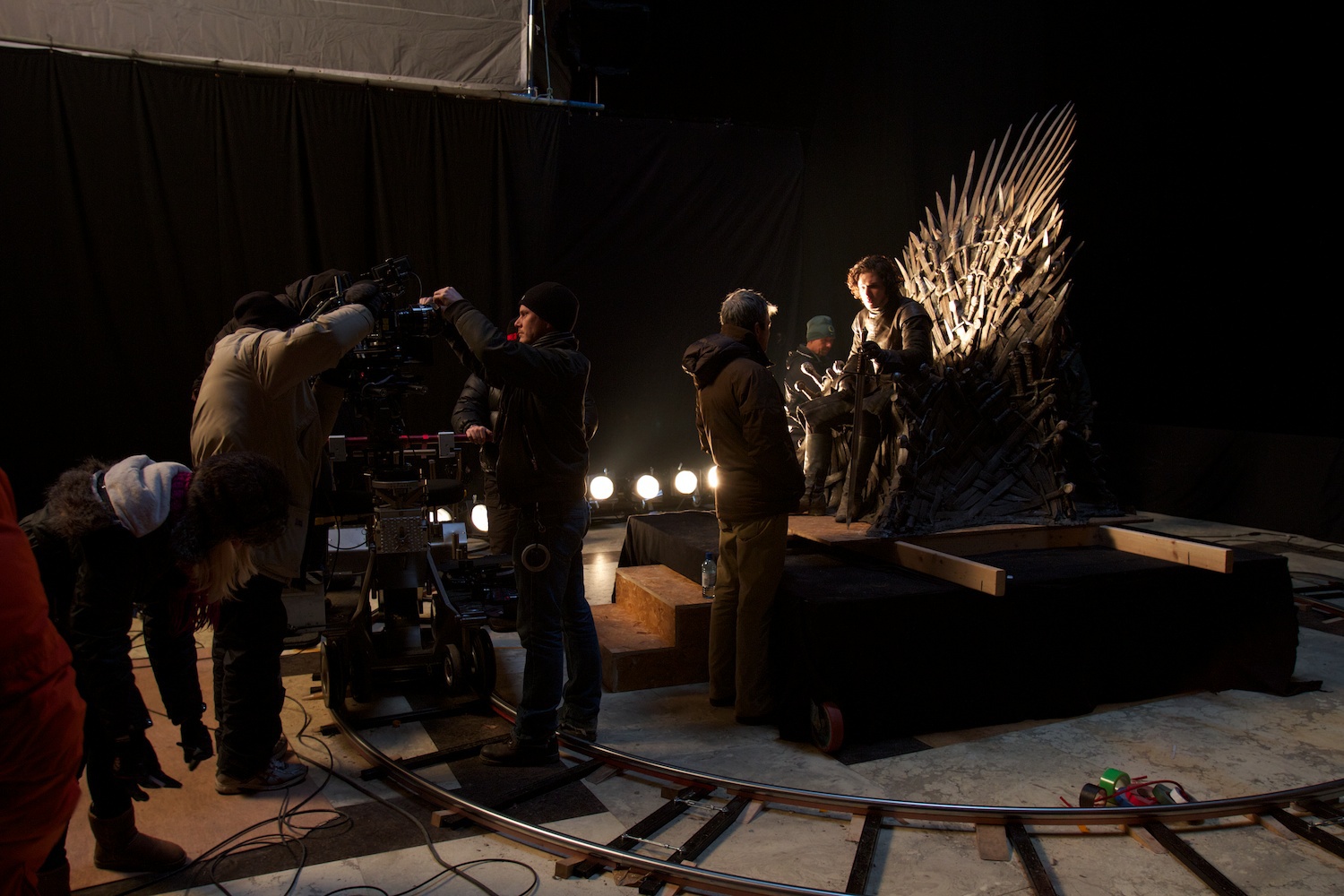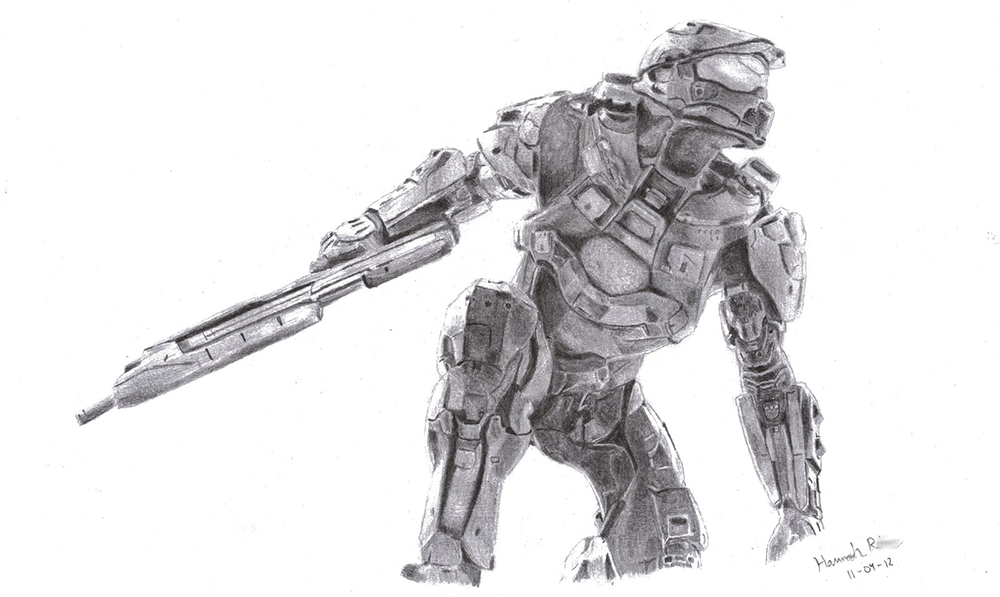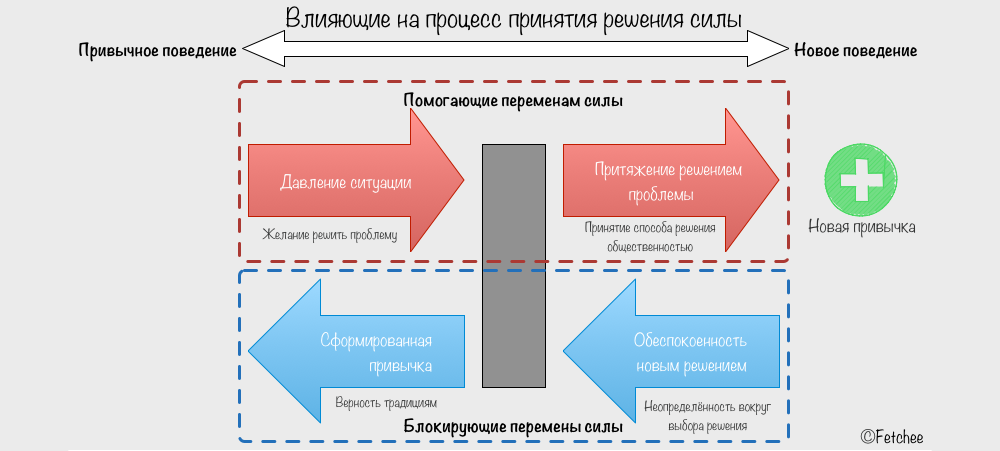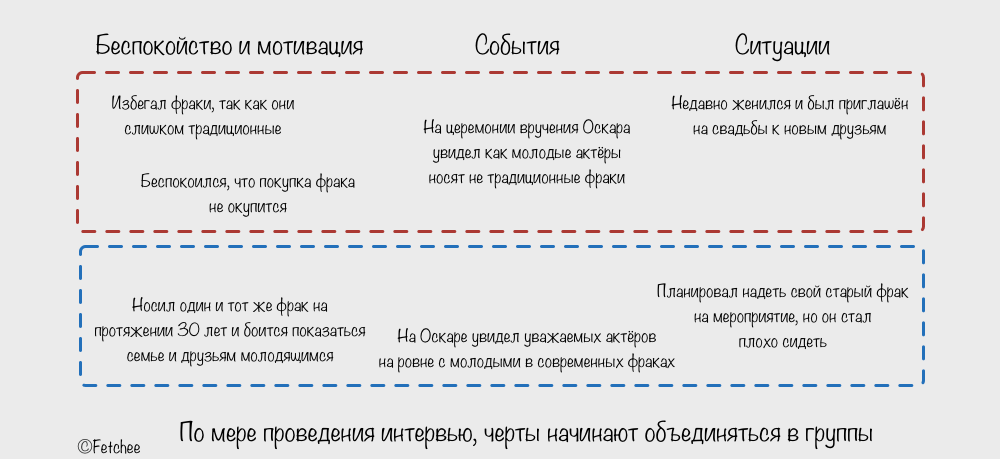From person to person in marketing or how to overcome WYSIATI
- Transfer

Actors rehearse the roles of their characters.
I present to you the longrid about the use of characters , the methodology that had a sobering effect on the development of our Fetchee project - a single wish list that monitors prices in all online stores in the world. The material is in no way a step-by-step instruction or training manual. His main task is to shake up and make fellow startups look at the main component of any business — their potential or existing customers, more widely.
To understand the material, you should already know what a person is (English persona) , try to compose at least one for your project, and only then continue reading.
So, I suggest you conduct a small mental experiment. Read the person’s description below and analyze how your brain reacts.
Igor is 30 years old; he was born, raised and works in St. Petersburg. Considers himself a real Russian man. Six months ago, he married in the same registry office as his parents 36 years ago. There were many friends at the wedding, even an uncle from Germany arrived.
Igor graduated from FINEC with a bachelor’s degree, but because of the crisis, he couldn’t find a job in his specialty. Since he was interested in computers since childhood, he learned to program quite well. This is what he earns.
Friends consider Igor stylish. His mother was an editor in a fashion magazine, and even after retiring, she often buys designer clothes. Igor does not often acquire new things, as he chooses only what suits him perfectly in style and color.
Igor is fond of tennis, playing the guitar and loves to read.
Recently Igor needed a wedding tuxedo and he just bought it at DLT .

Such a tuxedo was bought by Igor, well, almost ...
The story above is presented in the format of a typical marketing person . Anyone who reads it will have one of three processes in the brain:
- Instant unification of all facts into a finished story explaining why Igor bought this particular tuxedo and it was in the DLT. The brain itself will figure out the missing points.
- An unsuccessful attempt to collect all the facts in one story, which failed due to fatigue or lack of involvement in the described problem.
- A conscious decision to spend energy on creating a reliable story, a forced slowdown in processing speed and a transition to a more critical mode of perception. However, due to the lack of information for its reconstruction, the transition to a model of behavior No. 1 or No. 2.
Your mind is no exception, it behaved according to one of the scenarios, because it received a set of very disparate facts and the final result - Igor bought a tuxedo. However, he did not receive an answer to the question:
How are these facts about Igor related to his recent acquisition?
Due to the fact that people are built on a story created on the basis of consumer attributes, instead of explaining the reason for the purchase they made, they leave the brain in an unsatisfied state. To fix this, in a split second, the brain itself invents a story explaining the reason for Igor's purchase of this particular tuxedo.
The reason for this behavior of the brain - cognitive distortion , namely - the application of congenital mental template " What you see is what is " (English You See Is What All There Is, WYSIATI.) , Described by Daniel Kahneman .
This story briefly describes the personbut followers of applying this concept in marketing clearly did not expect the WYSIATI template to interfere with the process of filling in the missing facts. That is why the idea of persons has a devastating effect on all advertising activities of the company. After all, each member of the team ends the story of a person according to his personal assumption, which varies greatly from person to person.
To neutralize the effect of fragmented perceptions, persons should be replaced by a model that ensures that all facts of history are connected together. This model is called a character .
Persons filling in gaps and team

Attention! You are about to read the description of the person. Do not try to analyze or think of something. What you see is what it is. No more ...
Over the past years, many marketers have realized that people can create more problems than good. To fix this, they began to increase the size of the descriptions of persons and fill them with even more details. So, some of them began to occupy one or two pages of small printed text, carefully describing all the signs of an imaginary consumer.
Nevertheless, no amount of arbitrarily vivid signs will help to avoid gaps that our brain will fill in in the process of perceiving a person. Although events from precisely these gaps led the consumer to choose a specific product.If the reason for the choice is clearly not spelled out in the person, the brain will resort to the WYSIATI template and think out everything by itself.

The brain itself will compare all the facts as he wants. His task is to finish the story.
The brain works in this way, since it needs to establish a causal relationship between facts and events, to explain why everything happened exactly as described. If he discovers that there is not enough information, the subconscious will fill in the blanks on his own. Our brain specifically developed this ability during evolution. When something remotely resembling a predator suddenly jumps at us, the brain will immediately make the assumption that we are in danger, and will not begin to slowly assess the situation.
The main danger for advertising teams caused by such behavior is that each person forms his own point of view explaining why consumers buy or do not buy goods, which leads to a stratification of opinions and views within the group. Worst of all, team members will not even be aware of the process taking place with them, because it goes behind the scenes.
The good news is that there is hope. There is one thing in the person that makes them usable: they allow the team to quickly create a list of confirmed facts about consumers. Nevertheless, everything else in persons should be discarded.
You can save basic ideas about the consumer and add what is missing - causality .
The brain will believe in a story explaining why the consumer bought a particular product, but only if the information is provided in a certain way. To do this, you need to describe what worries the consumer, what motivates and motivates him, what events have occurred and in what situations he faced a purchase.
Combining all of the above, we get a character .
The consumer becomes a character

A sketch of the character - Master Cheif from Halo
Let's go back to the story about how Igor bought a tuxedo. Everything in it is pure truth, however, your brain feels a catch. He understands that the listed consumer attributes could not suddenly push him to purchase this tuxedo. In addition, he notes that part of the information is just noise, for example, that Igor plays the guitar.
The meaning is important for the brain - in our case, this is a story that it can believe in and which will explain the perfect purchase. It is for this that we will resort to the creation of a character.
So, a character can be called one who:
- Feels uneasy and motivated.
- Survives the events preceding the purchase.
- Faced with prior purchase situations.
We use the story of Igor as a starting point and create our first character. Let's start with anxiety and motivation.
Anxiety and motivation
Igor is not the first year thinking about buying a tuxedo, but he was always stopped by the following reasons:
- He does not like black, and most tuxedos are black.
- Over the past few years, Igor attended only a few official events.
- Igor does not want to waste money.
- Despite the fact that he does not like the look of the tuxedos rented and sitting, Igor cannot force himself to buy a thing that he cannot often use.

If you are familiar with the idea of hiring products to solve problems (Eng. Jobs To Be Done ) , in the diagram you will find out the forces that attract and repel consumers.
Disturbing and motivating factors are identified through surveys. The way to conduct them in this article cannot be described, but recently a book was published by the main ideologists of this methodology - Jobs To Be Done Handbook .
Next, we analyze the events preceding the purchase.
Upcoming Purchase Events

Living a life filled with certain anxieties and motivating factors, your characters will experience the events that push them to buy. Igor was faced with the following events:
- Recently, male movie stars and actors have worn non-standard tuxedos - the most notable among them were Tom Ford models. They caused a strong resonance in the industry of both high and mass fashion.
- Shortly before the purchase, Igor saw an advertisement for a new James Bond film, whose protagonist is known for his panache. In the video, he was wearing a dark blue tuxedo of not a classic cut. In addition, the new Bond actor turned out to be like Igor with his blond hair and blue eyes. All previous ones were with dark hair and eyes.
- Igor recently read an article in GQ about choosing a tuxedo. In addition to classic models, it also presented modern ones that can be worn for informal occasions, for example, with jeans and a regular daily shirt.
So far, we have looked at pre-purchase events through the prism of anxiety and motivating factors. By themselves, these events are not able to persuade to buy. Outweigh the scales may be prior to the purchase of the situation.
Prior purchase situations

Events that occur with the consumer before the purchase are passive in nature. These are the things that he sees, hears or experiences. In the end, consumers make a decision in favor of a particular product, as they are faced with one or more situations prior to the purchase. Here is a list of such situations for Igor:
- Recently, Igor got married and met many new people. It turned out that some of them are also going to celebrate the wedding soon and plan to invite him. This means that over the next year Igor will have to wear a tuxedo at least 2 times.
- Passing by the DLT, Igor saw a dark blue tuxedo in the window with a discount valid for a limited time. Quickly calculating the cost of renting a tuxedo for two events, Igor realized that buying a new one at a discount would cost him about the same money.
In both cases, Igor had to make a decision:
- Soon he will need a tuxedo, is it worth it to buy or can I rent?
- The sale will end soon, buy a tuxedo now or ignore the discount?
Characters for your product
As soon as you start interviewing your customers, you will begin to notice how they:
- Describe the same disturbing and motivating factors.
- They talk about similar events experienced before the purchase.
- They list almost the same situations in which they were faced with a purchase.
For example, suppose that DLT employees conducted a survey among customers and found that their harassing and motivating needs and situations are similar. We use this as the basis of our new character.
| Anxiety and motivation | Upcoming Purchase Events | Prior purchase situations |
|---|---|---|
|
|
|
Table No. 1. Character. Doubting tuxedo buyer.
Characteristics of your character will begin to gradually emerge as you conduct interviews with different people. You will begin to notice that they all share similar features, as well as that they will begin to group together.

Using characters to grow sales, advertising, and product development
The characters will help all employees involved in the development of new products. They will help the sales department understand how to reduce the level of anxiety among customers. Those responsible for advertising and marketing will be able to create ads that fit exactly the needs and expectations of the audience.

What are the characters missing?
Unfortunately, even the characters are not protected from the intervention of the WYSIATI template, but in their case this is not such a problem as for persons. Gaps filled by consciousness on their own are not important for the integrity of the whole story. It is funny that it is precisely on these non-fundamental points that all attention is concentrated in the development of persons. For example, on how the buyer looks, what he does in his free time, etc.
The character also does not describe the purchased product. This is done intentionally, since solving a consumer problem is a set of options, while a character himself is a set of facts. To write that a potential tuxedo buyer needs a tuxedo means to create a character that can only be used in one single case.
Characters exist throughout the life cycle of your product. They are keyholes for which solutions (keys) are selected. Sometimes keys are suitable, and sometimes not.
The above character model describes the buyer and the purchasing decision process. It is different from the user model. The most obvious difference is the need to replace events and situations that preceded the purchase with situations and expected results.
Starry corpse of your product
The term character was not without reason chosen to describe this model. Your consumers are actors playing the roles of different characters. Your product is the story these characters tell.
Consumers can play the role of one character, and sometimes several. Perhaps the consumer is looking for a tuxedo:
- For yourself
- For son, brother, father or friend.
- For my colleagues.
- For all of the above cases.
Another reason for the consumer to change his character may be his transition from the role of acquisition to the role of use.
Conclusion
Today we shared with you a free translation of the article, supplemented by links to useful materials and our own conclusions. The characters have become for us a reliable tool for the development of Fetchee. Only by describing all our consumers, putting their expectations on the shelves, disturbing and motivating factors, events that bring them among our users, we were able to focus on the really important functions of the application and anticipate the needs.
Understanding the problems facing consumers helped us find the best moments and places when representatives of each group recognize the need for our product, and then apply the appropriate advertising tools to attract them to our product through the correct emphasis on methods to solve their current problems(hello Jobs To Be Done) via Fetchee.
If the topic of this article is of interest to the Megamind community, then in the following publications we will talk in more detail about the characters developed for Fetchee and the influence of the revealed patterns on specific decisions in the development of our application.
